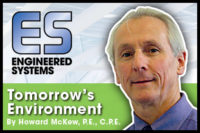Can I get a big, “THANK YOU?” I’d like to start the New Year on a positive note since I’m a person who always looks at the “glass half full.”
Over the years, I have routinely shared my experience as a youth. Growing up, my mother taught me to always say please and thank you. She never taught me which side of the dish the knife, fork, and spoon went, which seems to be very important to some people, moreso than saying, “please and thank you.” In fact, in my unofficial survey of the two topics, I have found that people concerned with table place settings are more inclined to not say “please and thank you”… but don’t quote me on this.
How does this discussion relate to the HVAC industry? Well, I find people tend to be too busy to stop and say “thank you.” This is especially true when it comes to clients stopping to take the time to assess and realize their consultant and/or contractor did a great job and exceeded the client’s expectations. Yes, clients are as obligated to thank someone just like they would, and do, expect the consultant and contractor to thank them for being awarded the job. Gosh, I could share a couple of projects where I was involved directly with the client and the resulting benefits saved the client millions of dollars but I never got a “thank you” for introducing my suggested innovative concept and the wonderful results. But I digress and will leave it as, “Thank you is a two-way street.”
From a consultant or HVAC contractor’s point of view, there are a few different ways to say “thank you” to the client. One of those ways of showing appreciation for the opportunity to work for a client is to contact the client leading up to a very hot or very cold day. When I managed an engineering group, I would ask each project engineer who was responsible for client follow-up on a completed project to contact the client to let her know of the upcoming weather report and that the expected temperature was going to be close to a “design-degree day.”
When reaching out to the client, an example request pertaining to a new on-line chiller plant would be as follows:
In two days, the temperature is expected to exceed 92ºF outdoors. In anticipation of this, could you have your building operator trend the following data:
- Outside dry bulb and wet bulb temperature
- Chilled water supply temperature, return temperature, and gpm
- Condenser water supply temperature, return temperature, and gpm
- Chiller kW
Think about this request. When was the last time you bought something and the seller followed up with a call asking how it was working? Interestingly, when I’ve told the principal of the company I worked for, it was not unusual to hear, “Gee, why did you do that? There is no fee left for this job and/or the project is closed out so don’t charge to the job number. You could be opening a can of worms!” Those kinds of responses never deterred me from continuing this proactive initiative because I was confident the project was working per design and, if it wasn’t, I wanted to know why so I could personally resolve the issue(s).
Reaching out to a client like this is another way of saying, “thank you.” I was grateful for the opportunity to have engineered the project. I wanted to make sure the system was working as designed, and I also wanted the client to take the time to find out the project was working as designed if not better than anticipated.
Now the client may not have recognized my “thank you” in me making this call to him or her, but subliminally this was another way of me saying this. Now if the client would have only responded with a “thank you” back to me!
Then there is the traditional, more boring way of saying “thank you” by sending a card to the client after the job has been completed. Unfortunately, the sender will spoil the occasion by adding in, “I hope we can help you again soon.” Now the sender just turned the card into a marketing initiative.
What is your “thank you” experience in the HVAC industry?




